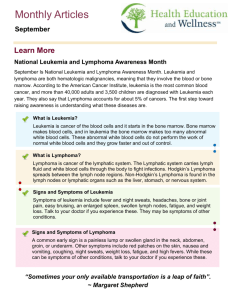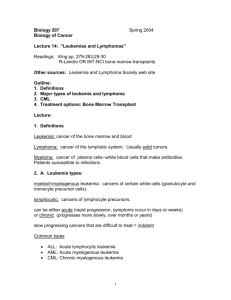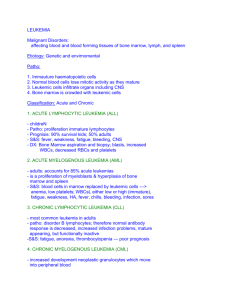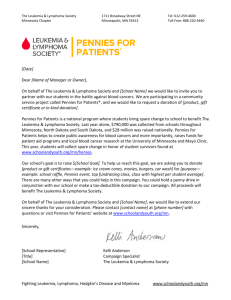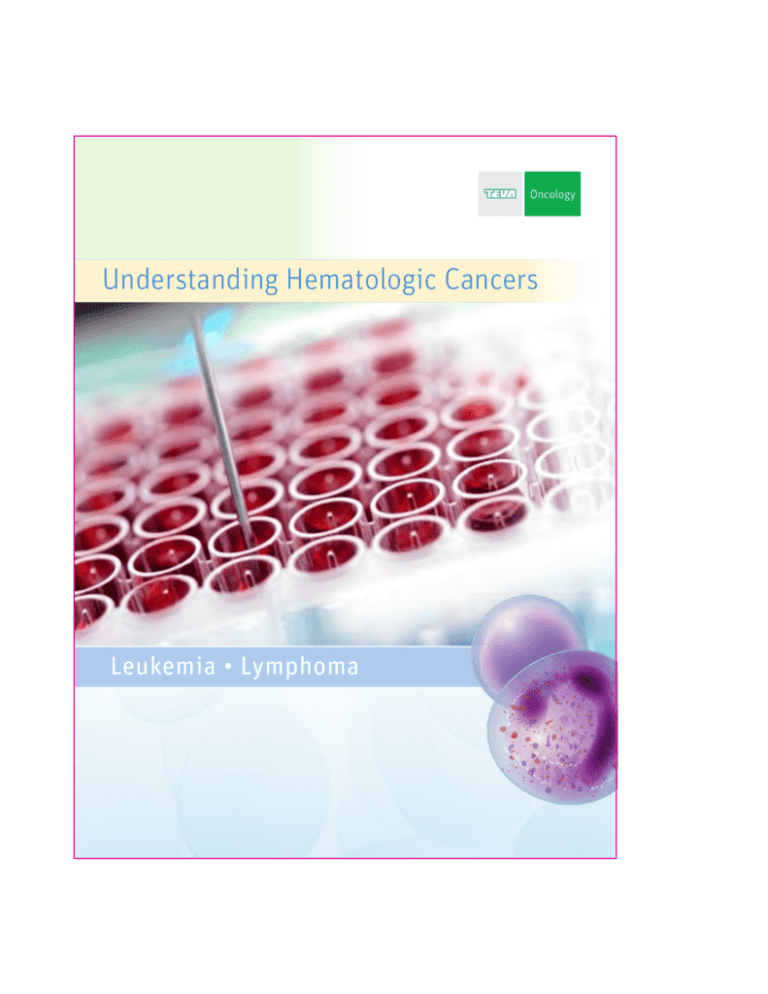
Understanding Hematologic Cancers
Leukemia • Lymphoma
Blood
Blood
Blood is made of three types of cells that float in a watery
liquid called plasma:1,2
1. Red blood cells (RBCs) carry oxygen throughout
the body.
2. White blood cells (WBCs) help to fight infection
and invasion by foreign organisms.
3. P
latelets help to form clots that prevent bleeding.
White Blood Cells
White blood cells are part of your immune system. They fight infections in your body.2,3
Three main categories of white blood cells:2-6
1.Lymphocytes:
T cells: destroy infected cells; direct other cells in the immune system
B cells: make antibodies to destroy foreign substances
NK cells: attack cancer cells and viruses
2. Monocytes: ingest damaged or dead cells
3. Granulocytes:
Neutrophils: kill and ingest bacteria
Basophils: aid in the allergic response
Eosinophils: kills parasites and cancer cells; aid in the allergic response
White blood cells are the
cells affected by leukemia
and lymphoma.2,3
How are blood cells made?
All blood cells are generated from the bone marrow
from special cells called stem cells. Stem cells
develop into two cell lines (like family trees). The
ancestors of these lines are called lymphoid and
myeloid stem cells:7-9
• L ymphoid stem cells develop
into lymphoid blasts and then
into lymphocytes.
• Myeloid stem cells develop into myeloid
blasts, and then into red blood cells,
platelets, granulocytes, and monocytes.
All cells move from the bone marrow into the
bloodstream. Lymphocytes are stored in lymph
nodes, part of the body’s lymphatic system,
which acts as a filtration system and mounts
an immune response.8,10
Blood & Bone
Bone Marrow: Where blood is made
Inside the hollow spaces of long flat bones, there is a spongy tissue called bone marrow that
contains fat, blood, and stem cells. Stem cells are immature cells that can develop into red blood
cells, white blood cells, or platelets.11
Blood & Bone
As blood cells develop in the bone marrow, they seep into the blood that flows through bone and
make their way into the body’s bloodstream. Each type of cell has a different average lifespan. Red
blood cells live for about 4 months, platelets live only about 10 days, and different types of white
blood cells live from days to years. For this reason, our bodies need a constant production of blood
cells throughout our lives.11
The body has a feedback system that can determine when there are not enough red blood cells
carrying oxygen to other tissues and cells. A signal is sent to the kidneys to release a hormone
that in turn signals the stem cells in the bone marrow to produce more red blood cells. White blood
cell production is triggered by infection or foreign organisms. Platelet production increases when
bleeding occurs.11
How can cancer affect
blood and bone?
Certain cancers affect the bone marrow and
blood. Leukemia is a cancer that causes the
bone marrow to produce abnormal white blood
cells. Lymphoma is cancer of the lymphatic
system caused by abnormal lymphocytes.5,6
ne
ells in bo marrow
od c
o
l
B
Lymphatic System
The lymphatic system is a network of vessels, lymph nodes, and organs that runs throughout the
body, collecting excess fluid, filtering it, and returning it to the bloodstream. The tonsils, adenoids,
spleen, and thymus belong to the lymphatic system. Lymphocytes, a type of white blood cell that
fight against bacteria and viruses, flow through this network in fluid, called lymph.10
Excess fluid in the body that is not absorbed when blood circulates through tissues is drawn into the
small capillaries of the lymphatic system. From there, it flows into small sacs, or lymph nodes, and
is filtered. The cleaned fluid flows back out of the nodes and into the lymphatic network, which then
empties into veins of the bloodstream at the base of the neck. Lymph nodes are located throughout
the network where they store lymphocytes and help to fight infection. Many lymph nodes are
clustered in the armpits, neck, female breasts, and groin.10,12
How can cancer affect the lymphatic system?
Ly
mp
h
de
no
Lymphatic System
Lymphatic
system
The lymphatic system plays a role in the spread of all types of cancers.
When cancer cells get into the lymphatic system, they are spread
throughout the body. Lymphoma is a type of cancer that specifically
affects the lymphatic system. It occurs when abnormal lymphocytes
become lymphoma cells, which then multiply, grow, and collect in
lymph nodes, impairing the immune system.6,12
Lymphocytes in ly
mph
nod
e
Hematologic Cancers
Hematologic cancers can affect the blood, bone marrow, and lymphatic system. The word “hematologic”
comes from the Greek word “haima”, which means blood. This group of cancers includes leukemia and
lymphoma. More than 100,000 people are diagnosed with hematologic cancers in the United States
each year.13,14
Leukemia
There are several types of leukemia. They can be acute or chronic and can affect the blood and bone
marrow. “Acute” describes a type of cancer that grows quickly, whereas “chronic” refers to cancers that
grow more slowly. In leukemia, immature white blood cells, called lymphoblasts, multiply uncontrollably.
They take up more and more space in the bone marrow, preventing healthy red and white blood cells and
platelets from developing. Leukemia is classified by the type of bone marrow cells that it affects —
some leukemia starts in myeloid cells (called myeloid leukemia) and other types in lymphocytes (called
lymphocytic leukemia).15,16
Lymphoma
d
Lymphomas are cancers that affect the lymph nodes and
lymphatic system. There are two main types—Hodgkin
lymphoma and non-Hodgkin lymphoma. The second type
is more common. The cause of lymphoma is unknown.15
in lymph node
ma
pho
m
Ly
Hematologic Cancers
Leu
k
em
ia
in
Leuk
emi
a in
blo
o
n
bo
ow
arr
m
e
Card with overlay pulled down
• Neutrophils kill and ingest bacteria
• Basophils aid in the allergic response
• Eosinophils kill parasites and cancer cells
and aid in the allergic response
• Monocytes ingest damaged or dead cells
“Chronic” means that the disease grows more slowly than other types of leukemia.18,19
9
Chronic Myelogenous Leukemia (CML)
Chronic myelogenous leukemia (CML) is a cancer that begins in
myeloid stem cells. Myeloid stem cells normally develop into:3,17,18
Philadelphia
Chromosome
22
BCR-ABL
ABL
BCR
Philadelphia chromosome
• Neutrophils kill and ingest bacteria
• Basophils aid in the allergic response
• Eosinophils kill parasites and cancer cells
and aid in the allergic response
• Monocytes ingest damaged or dead cells
“Chronic” means that the disease grows more slowly than other types of leukemia.
CML
Chronic myelogenous leukemia (CML) is a cancer that begins in
myeloid stem cells. Myeloid stem cells normally develop into:3,17,18
CML
Chronic Myelogenous Leukemia (CML)
9
Philadelphia
Chromosome
22
BCR-ABL
ABL
BCR
Philadelphia chromosome
CML is caused by a genetic abnormality or mutation in bone marrow myeloid stem cells, in which part of a chromosome
breaks off and attaches to another chromosome. The resulting chromosome is called the “Philadelphia chromosome.”
Two genes, called BCR and ABL, fuse and cause myeloid cells to produce an abnormal enzyme (called tyrosine kinase)
that triggers white blood cells to grow uncontrollably. Although most CML cells are produced in the bone marrow, they
may be produced in the spleen and liver as well.17-19
CML is caused by a genetic abnormality or mutation in bone marrow myeloid stem cells, in which part of a chromosome
breaks off and attaches to another chromosome. The resulting chromosome is called the “Philadelphia chromosome.”
Two genes, called BCR and ABL, fuse and cause myeloid cells to produce an abnormal enzyme (called tyrosine kinase)
that triggers white blood cells to grow uncontrollably. Although most CML cells are produced in the bone marrow, they
may be produced in the spleen and liver as well.17-19
At the start of the disease, there is an increase in normal-appearing white blood cells and platelets. Early in the chronic
stage of CML patients may not have symptoms. Patients may feel fatigued, lose weight, develop night sweats, and
have a feeling of abdominal fullness. The disease may progress to an accelerated phase. Eventually, only CML cells
are produced, and the spleen may become grossly enlarged. This is serious event called a blast crisis.19
At the start of the disease, there is an increase in normal-appearing white blood cells and platelets. Early in the chronic
stage of CML patients may not have symptoms. Patients may feel fatigued, lose weight, develop night sweats, and
have a feeling of abdominal fullness. The disease may progress to an accelerated phase. Eventually, only CML cells
are produced, and the spleen may become grossly enlarged. This is serious event called a blast crisis.19
Treatment
Treatment
Treatment of CML may include chemotherapy, stem cell transplantation, and other drugs that block tyrosine kinase.
19
Treatment of CML may include chemotherapy, stem cell transplantation, and other drugs that block tyrosine kinase.19
Card with overlay pulled down
Chronic Lymphocytic Leukemia (CLL)
Chronic Lymphocytic Leukemia (CLL)
In patients with CLL, the lymphocytes mature partially but not completely, and therefore, they are
not as effective in fighting infection. These partially mature cells live longer and build up over a long
time in the bone marrow and blood. As they increase in number, they prevent normal cells from developing.
Because there are fewer oxygen-carrying red blood cells, patients may have symptoms of anemia such as
fever, weakness, and paleness. Having fewer white blood cells increases the risk of infection. Patients may
also bruise and bleed more easily because of reduced platelets. CLL cells also spread through the blood to
the lymph nodes, liver, and spleen, causing swelling and abdominal fullness.20-22
In patients with CLL, the lymphocytes mature partially but not completely, and therefore, they are
not as effective in fighting infection. These partially mature cells live longer and build up over a long
time in the bone marrow and blood. As they increase in number, they prevent normal cells from developing.
Because there are fewer oxygen-carrying red blood cells, patients may have symptoms of anemia such as
fever, weakness, and paleness. Having fewer white blood cells increases the risk of infection. Patients may
also bruise and bleed more easily because of reduced platelets. CLL cells also spread through the blood to
the lymph nodes, liver, and spleen, causing swelling and abdominal fullness.20-22
Treatment
Treatment
The most common type of CLL, occurring in about 95% of patients, affects B cells. Another type affects
T cells. Treatment depends on knowing which cells are affected. Some cases of CLL progress very slowly
and usually do not require treatment. Other cases can progress quickly and are more serious. Laboratory
tests help doctors determine which type a patient has. When treatment is needed, patients may receive
chemotherapy to kill cancer cells and other drugs to treat symptoms.20-22
The most common type of CLL, occurring in about 95% of patients, affects B cells. Another type affects
T cells. Treatment depends on knowing which cells are affected. Some cases of CLL progress very slowly
and usually do not require treatment. Other cases can progress quickly and are more serious. Laboratory
tests help doctors determine which type a patient has. When treatment is needed, patients may receive
chemotherapy to kill cancer cells and other drugs to treat symptoms.20-22
CLL
Chronic lymphocytic leukemia (CLL) is a cancer that affects lymphocytes, the white blood
cells that develop in the bone marrow and aid in fighting infections and foreign invaders.
“Chronic” means that the disease grows slowly in comparison to other types of leukemia.20,21
CLL
Chronic lymphocytic leukemia (CLL) is a cancer that affects lymphocytes, the white blood
cells that develop in the bone marrow and aid in fighting infections and foreign invaders.
“Chronic” means that the disease grows slowly in comparison to other types of leukemia.20,21
Card with overlay pulled down
Acute myeloid leukemia (AML) is the most common type of leukemia in adults and mostly affects those older than 65.
It is a cancer that begins in myeloid stem cells of the bone marrow. Normally, these myeloid cells would develop into
neutrophils, and other types of white blood cells. Instead, immature myeloid stem cells, called myeloblasts, multiply in
the bone marrow and destroy the cells that would produce normal blood cells and platelets. These abnormal cells move
quickly from the bone marrow into the blood and may spread to the lymph nodes, liver, spleen, brain, spinal cord, and
testes, where they continue to divide and multiply. They may form small masses of cells under the skin and gums or in
the eyes. The quick spread of the disease is indicated by the term “acute,” which means rapidly growing.23-25
Acute myeloid leukemia (AML) is the most common type of leukemia in adults and mostly affects those older than 65.
It is a cancer that begins in myeloid stem cells of the bone marrow. Normally, these myeloid cells would develop into
neutrophils, and other types of white blood cells. Instead, immature myeloid stem cells, called myeloblasts, multiply in
the bone marrow and destroy the cells that would produce normal blood cells and platelets. These abnormal cells move
quickly from the bone marrow into the blood and may spread to the lymph nodes, liver, spleen, brain, spinal cord, and
testes, where they continue to divide and multiply. They may form small masses of cells under the skin and gums or in
the eyes. The quick spread of the disease is indicated by the term “acute,” which means rapidly growing.23-25
A distinct subtype of AML is caused by a specific genetic abnormality
or mutation in two chromosomes in cells developing from myeloid
cells into neutrophils. These developing neutrophils are called
promyelocytes, which gives this type of AML its name — acute
promyelocytic leukemia (APL). The chromosomal change that
generates the fusion protein called PML-RARa, prevents normal
cell development and causes these abnormal promyelocytes
to accumulate.25,26
A distinct subtype of AML is caused by a specific genetic abnormality
or mutation in two chromosomes in cells developing from myeloid
cells into neutrophils. These developing neutrophils are called
promyelocytes, which gives this type of AML its name — acute
promyelocytic leukemia (APL). The chromosomal change that
generates the fusion protein called PML-RARa, prevents normal
cell development and causes these abnormal promyelocytes
to accumulate.25,26
Treatment
Treatment with chemotherapy is designed to destroy leukemia cells by
either killing them or helping them to mature (or differentiate) normally,
leading to remission. Some patients undergo stem cell transplantation
or therapy with a drug related to vitamin A.25
AML in the skin
Treatment
Treatment with chemotherapy is designed to destroy leukemia cells by
either killing them or helping them to mature (or differentiate) normally,
leading to remission. Some patients undergo stem cell transplantation
or therapy with a drug related to vitamin A.25
AML in the skin
AML/APL
Acute Myeloid Leukemia (AML)/Acute Promyelocytic Leukemia (APL)
AML/APL
Acute Myeloid Leukemia (AML)/Acute Promyelocytic Leukemia (APL)
Card with overlay pulled down
Acute Lymphocytic Leukemia (ALL)
Acute Lymphocytic Leukemia (ALL)
Acute lymphocytic leukemia (ALL) is a cancer that begins in the bone marrow and affects
lymphocytes, the white blood cells that help to fight infections and foreign invaders. “Acute” means
that the cancer cells multiply and spread quickly. These cancer cells can spread to the lymph nodes,
liver, spleen, brain, spinal cord, and testes (in men).27
Acute lymphocytic leukemia (ALL) is a cancer that begins in the bone marrow and affects
lymphocytes, the white blood cells that help to fight infections and foreign invaders. “Acute” means
that the cancer cells multiply and spread quickly. These cancer cells can spread to the lymph nodes,
liver, spleen, brain, spinal cord, and testes (in men).27
In patients with ALL, the bone marrow produces immature lymphocytes that replace normal cells in the marrow.
Patients may have bone and joint pain, swollen glands, infections, fever, easy bruising and bleeding, weakness,
fatigue, loss of appetite and weight, and night sweats. They may also have tiny red spots the size of pinpoints
on the skin.27,28
In patients with ALL, the bone marrow produces immature lymphocytes that replace normal cells in the marrow.
Patients may have bone and joint pain, swollen glands, infections, fever, easy bruising and bleeding, weakness,
fatigue, loss of appetite and weight, and night sweats. They may also have tiny red spots the size of pinpoints
on the skin.27,28
ALL is the least common type of leukemia in adults. But it is
the most common type of leukemia in children and usually
affects young children who are 3 to 7 years old.27-29
ALL is the least common type of leukemia in adults. But it is
the most common type of leukemia in children and usually
affects young children who are 3 to 7 years old.27-29
Treatment
Treatment
The goal of treatment of ALL is to increase the number of normal
blood cells by killing the abnormal cells. Chemotherapy with several
drugs is usually given in 3 phases over a 2-year period. Children
may also undergo stem cell transplantation. Drugs that target an
abnormal chromosome that occurs in about 25% of adults with
ALL may be used in these patients.28,30-33
The goal of treatment of ALL is to increase the number of normal
blood cells by killing the abnormal cells. Chemotherapy with several
drugs is usually given in 3 phases over a 2-year period. Children
may also undergo stem cell transplantation. Drugs that target an
abnormal chromosome that occurs in about 25% of adults with
ALL may be used in these patients.28,30-33
ALL in the skin
ALL in the skin
ALL
ALL
Card with overlay pulled down
B-Cell Non-Hodgkin Lymphoma (NHL): Follicular Lymphoma
B-Cell Non-Hodgkin Lymphoma (NHL): Follicular Lymphoma
Non-Hodgkin Lymphoma (NHL) is a type of cancer that affects the lymphatic system. It usually
begins in the lymphocytes of the lymph nodes, spleen, and bone marrow. Follicular lymphoma
is a type of NHL that affects the B cells, the cells that make antibodies to protect against germs.
The word “follicular” refers to the circular pattern in which the cancer cells grow in the lymph nodes.
Follicular lymphoma accounts for about 20% of lymphoma in the United States.6,34,35
Non-Hodgkin Lymphoma (NHL) is a type of cancer that affects the lymphatic system. It usually
begins in the lymphocytes of the lymph nodes, spleen, and bone marrow. Follicular lymphoma
is a type of NHL that affects the B cells, the cells that make antibodies to protect against germs.
The word “follicular” refers to the circular pattern in which the cancer cells grow in the lymph nodes.
Follicular lymphoma accounts for about 20% of lymphoma in the United States.6,34,35
NHL occurs when mature lymphocytes in the lymphatic
system become abnormal and multiply. These abnormal cells
don’t die when they should, and they don’t protect the body
against infection. As the cells build up, they often form tumors.
Follicular lymphoma is slow-growing and occurs most often
in older people. It is usually not treated when it is first found,
but over time follicular lymphoma can change to rapidly
spreading diffuse B-cell lymphoma that requires treatment.35,36
NHL occurs when mature lymphocytes in the lymphatic
system become abnormal and multiply. These abnormal cells
don’t die when they should, and they don’t protect the body
against infection. As the cells build up, they often form tumors.
Follicular lymphoma is slow-growing and occurs most often
in older people. It is usually not treated when it is first found,
but over time follicular lymphoma can change to rapidly
spreading diffuse B-cell lymphoma that requires treatment.35,36
Treatment
Treatment
The exact cause of lymphoma is unknown, but it is
thought that NHL may be caused by viruses. Treatments
include chemotherapy, drugs to treat symptoms, stem
cell transplantation, biological therapies, and radiation.6,37
The exact cause of lymphoma is unknown, but it is
thought that NHL may be caused by viruses. Treatments
include chemotherapy, drugs to treat symptoms, stem
cell transplantation, biological therapies, and radiation.6,37
Enlarged lymph node in neck
Enlarged lymph node in neck
Follicular Lymphoma
Follicular Lymphoma
Card with overlay pulled down
Diffuse Large B-Cell Lymphoma (DLBCL)
Diffuse Large B-Cell Lymphoma (DLBCL)
Diffuse large B-cell lymphoma (DLBCL) is the most common type of non-Hodgkin lymphoma
in the US. It affects B-cells in the lymphatic system and occurs most often in older people.
Its name comes from the fact that the cancer cells appear large under a microscope. It usually
begins in the lymph nodes of the chest, abdomen, neck, or armpit. Sometimes the lymphoma
cells stay in just one area of the body, making the disease easier to treat. Although DLBCL cells grow
quickly, this disease usually responds to treatment.34
Diffuse large B-cell lymphoma (DLBCL) is the most common type of non-Hodgkin lymphoma
in the US. It affects B-cells in the lymphatic system and occurs most often in older people.
Its name comes from the fact that the cancer cells appear large under a microscope. It usually
begins in the lymph nodes of the chest, abdomen, neck, or armpit. Sometimes the lymphoma
cells stay in just one area of the body, making the disease easier to treat. Although DLBCL cells grow
quickly, this disease usually responds to treatment.34
DLBCL occurs when mature lymphocytes in the
lymphatic system become abnormal and multiply.
These abnormal cells don’t die when they should,
and they don’t protect the body against infection.
As the cells build up, they often form tumors.35,36
DLBCL occurs when mature lymphocytes in the
lymphatic system become abnormal and multiply.
These abnormal cells don’t die when they should,
and they don’t protect the body against infection.
As the cells build up, they often form tumors.35,36
Treatment
Treatment
Because it grows quickly, DLBCL must be treated right
away. Treatments include chemotherapy with several
drugs, drugs to treat symptoms and infection, biological
therapies, and sometimes stem cell transplantation.
Initial treatment is successful for most patients.38
Because it grows quickly, DLBCL must be treated right
away. Treatments include chemotherapy with several
drugs, drugs to treat symptoms and infection, biological
therapies, and sometimes stem cell transplantation.
Initial treatment is successful for most patients.38
Enlarged lymph node in neck
Enlarged lymph node in neck
DLBLC
DLBLC
References
1.Merck Manual. Overview of blood. http://www.merckmanuals.com/home/blood_disorders/biology_of_blood/overview_of_blood.html.
Last revision August 2006 by Eugene P. Frenkel, MD. Accessed August 6, 2012.
2.Public Broadcast System. What is blood made of? In: Red Gold: The Epic Story of Blood [online].
http://www.pbs.org/wnet/redgold/printable/p_whatisblood.html. Published 2002. Accessed August 6, 2012.
3.Merck Manual. Components of blood. http://www.merckmanuals.com/home/blood_disorders/biology_of_blood/components_of_blood.html.
Last revision August 2006 by Eugene P. Frenkel, MD. Accessed August 6, 2012.
4. National Heart, Lung and Blood Institute. What is lymphocytopenia? Accessed August 6, 2012.
5.American Society of Hematology. Leukemia. http://www.hematology.org/Patients/Blood-Disorders/Blood-Cancers/5230.aspx. Accessed August 6, 2012.
6.American Society of Hematology. Lymphoma. http://www.hematology.org/Patients/Blood-Disorders/Blood-Cancers/5231.aspx. Accessed August 6, 2012.
7.National Institutes of Health. Hematopoietic Stem Cells. In Stem Cell Information. Bethesda, MD: National Institutes of Health, US Department of Health and Human Services; 2011.
http://stemcells.nih.gov/info/scireport/chapter5. Accessed August 6, 2012.
8.Public Broadcast System. How is blood produced? In: Red Gold: The Epic Story of Blood [online].
http://www.pbs.org/wnet/redgold/printable/p_bloodproduction.html. Published 2002. Accessed August 6, 2012.
9. Smith C. Hematopoietic stem cells and hematopoiesis. Cancer Control. 2003;10(1):9-16.
10.CancerQuest. Anatomy of the lymphatic system. http://www.cancerquest.org/anatomy-lymphatic-system.html. Last modified June 6, 2012.
Accessed August 6, 2012.
11.The MDS Foundation, Inc. What Does My Bone Marrow Do? Yardville, NJ: The MDS Foundation, Inc.
http://www.mds-foundation.org/?s=what+does+my+bone+marrow+do. Accessed August 6, 2012.
12.Medline Plus, a services of the US National Library of Medicine. Lymphatics and the breast.
http://www.nlm.nih.gov/medlineplus/ency/anatomyvideos/000084.htm. Updated November 23, 2010 by Todd Gersten, MD. Accessed August 7, 2012.
13.Centers for Disease Control and Prevention. Blood cancers: leukemia, lymphoma, and myeloma.
http://www.cdc.gov/fatures/hematologiccancers/. Last updated May 21, 2012. Accessed August 7, 2012.
14.Mosby’s Dictionary of Medicine, Nursing & Health Professions. Hematology. http://www.nursingconsult.com/nursing/index. Accessed August 8, 2012.
15.Maimonides Cancer Center. About hematologic cancers. http://www.maimonidesmed.org/CancerCenter/AboutHematologicCancers.aspx.
Accessed August 7, 2012.
16. Cancer Quest. Leukemia: types. http://www.cancerquest.org/types-of-leukemia.html. Last modified June 1, 2012. Accessed August 6, 2012.
17.American Society of Clinical Oncology. Leukemia—chronic myeloid—CML.
http://www.cancer.net/patient/Cancer+Types/Leukemia+-+Chronic+Myeloid+-+CML. Last updated May 15, 2012. Accessed August 6, 2012.
18.American Cancer Society. Leukemia—chronic myeloid.
http://www.cancer.org/Cancer/Leukemia-ChronicMyeloidCML/DetailedGuide/leukemia-chronic-myeloid-myelogenous-what-is-c-m-l.
Last revised June 4, 2012. Accessed August 6, 2012.
19.Merck Manual. Chronic myelocytic leukemia (CML).
http://www.merckmanuals.com/home/blood_disorders/leukemias/chronic_myelocytic_leukemia_cml.html. Last revision June 2008 by Emil J Freireich, MD.
Accessed August 6, 2012.
20.American Society of Clinical Oncology. Leukemia—chronic lymphocytic—CLL.
http://www.cancer.net/patient/Cancer+Types/Leukemia+-+Chronic+Lymphocytic+-+CLL. Last updated May 11, 2012. Accessed August 6, 2012.
21.American Cancer Society. Leukemia—chronic lymphocytic.
http://www.cancer.org/Cancer/Leukemia-ChronicLymphocyticCLL/DetailedGuide/leukemia-chronic-lymphocytic-what-is-cll.
Last revised April 22, 2012. Accessed August 6, 2012.
22.Merck Manual. Chronic lymphocytic leukemia (CLL).
http://www.merckmanuals.com/home/blood_disorders/leukemias/chronic_lymphocytic_leukemia_cll.html. Last revision June 2008 by Emil J Freireich, MD.
Accessed August 6, 2012.
23.American Cancer Society. Leukemia—acute myeloid leukemia.
http://www.cancer.org/Cancer/Leukemia-AcuteMyeloidAML/DetailedGuide/leukemia-acute-myeloid-myelogenous-what-is-aml.
Last revised March 22, 2012. Accessed August 6, 2012.
24.American Society of Clinical Oncology. Leukemia—acute myeloid—AML.
http://www.cancer.net/patient/Cancer+Types/Leukemia+-+Acute+Myeloid+-+AML. Last updated May 18, 2012. Accessed August 6, 2012.
25.Merck Manual. Acute myelocytic leukemia (AML).
http://www.merckmanuals.com/home/blood_disorders/leukemias/acute_myelocytic_leukemia_aml.html. Last revision June 2008 by Emil J Freireich, MD.
Accessed August 6, 2012.
26.Welsh JS, Yuan W, Ley TJ. PML-RARA can increase hematopoietic self-renewal without causing a myeloproliferative disease in mice. J Clin Invest. 2011;121(4):1636-1645.
27.American Cancer Society. What is acute lymphocytic leukemia?
http://www.cancer.org/Cancer/Leukemia-AcuteLymphocyticALLinAdults/DetailedGuide/leukemia-acute-lymphocytic-what-is-all.
Last revised August 9, 2012. Accessed September 19, 2012.
28.Medline Plus, a services of the US National Library of Medicine. Acute lymphocytic leukemia (ALL).
http://www.nlm.nih.gov/medlineplus/ency/article/000541.htm. Updated February 7, 2012. Accessed September 18, 2012.
29.American Cancer Society. What are the key statistics about acute lymphocytic leukemia?
http://www.cancer.org/Cancer/Leukemia-AcuteLymphocyticALLinAdults/DetailedGuide/leukemia-acute-lymphocytic-key-statistics.
Last revised June 25, 2012. Accessed September 19, 2012.
30.American Cancer Society. How is acute lymphocytic leukemia treated?
http://www.cancer.org/Cancer/Leukemia-AcuteLymphocyticALLinAdults/DetailedGuide/leukemia-acute-lymphocytic-treating-general-info.
Last revised August 9, 2012. Accessed September 19, 2012.
31.American Cancer Society. Chemotherapy for acute lymphocytic leukemia.
http://www.cancer.org/Cancer/Leukemia-AcuteLymphocyticALLinAdults/DetailedGuide/leukemia-acute-lymphocytic-treating-chemotherapy. Last revised August 9, 2012.
Accessed September 19, 2012.
32.American Cancer Society. Targeted therapy for acute lymphocytic leukemia.
http://www.cancer.org/Cancer/Leukemia-AcuteLymphocyticALLinAdults/DetailedGuide/leukemia-acute-lymphocytic-treating-targeted-therapy.
Last revised August 9, 2012. Accessed September 19, 2012.
33.American Cancer Society. Treatment of children with acute lymphocytic leukemia.
http://www.cancer.org/Cancer/LeukemiainChildren/DetailedGuide/childhood-leukemia-treating-children-with-all.
Last revised June 29, 2012. Accessed September 19, 2012.
34.American Cancer Society. Non-Hodgkin lymphoma. Type of non-Hodgkin lymphoma.
http://www.cancer.org/Cancer/Non-HodgkinLymphoma/DetailedGuide/non-hodgkin-lymphoma-types-of-non-hodgkin-lymphoma.
Last revised January 26, 2012. Accessed August 6, 2012.
35.American Cancer Society. Non-Hodgkin lymphoma overview.
http://www.cancer.org/Cancer/Non-HodgkinLymphoma/OverviewGuide/non-hodgkin-lymphoma-overview-what-is-non-hodgkin-lymphoma.
Last revised February 3, 2012. Accessed August 6, 2012.
36.National Cancer Institute. What You Need To Know About™ non-Hodgkin lymphoma.
http://cancer.gov/cancertopics/wyntk/non-hodgkin-lymphoma/page2. Posted February 12, 2008. Accessed August 8, 2012.
37.Merck Manual. Non-Hodgkin lymphoma. http://www.merckmanuals.com/home/blood_disorders/lymphomas/non-hodgkin_lymphomas.html#v776282.
Last revision August 2008 by Carol S. Portlock, MD. Accessed August 6, 2012.
38.Lymphoma Research Foundation. Diffuse large B-cell lymphoma.
http://www.lymphoma.org/site/pp.asp?c=bkLTKaOQLmK8E&b=6300153&utm_source=google&utm_term=diffuse%20large%20b-cell%20lymphoma&utm_
campaign=DLBCL&utm_medium=cpc&utm_content=sM3fKttl0|14311341388|diffuse%20large%20b-cell%20lymphoma|e|&gclid=COzNpqe8wbICFYk7Ogod52cAPg.
Accessed September 19, 2012.
©2012 Cephalon, Inc., a wholly owned subsidiary of Teva Pharmaceutical Industries Ltd.
All rights reserved. ONC-2242 October 2012.




